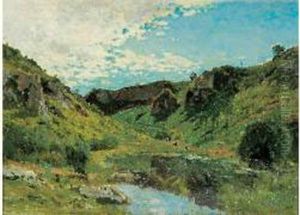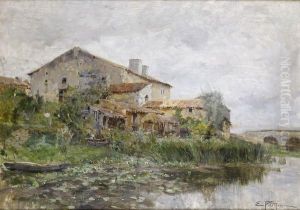Edouard Petitjean Paintings
Edouard Petitjean was a French painter born on July 5, 1844, in Neufchâteau, in the Vosges department of France. He is most renowned for his contributions to the Post-Impressionist movement, though his style also encompassed elements of Impressionism. Petitjean's oeuvre is characterized by a vibrant palette, a keen interest in the play of light, and a commitment to capturing the beauty of the French landscape and seascapes. His artistic journey reflects an evolution from more traditional academic painting towards a freer, more expressive approach that sought to capture the essence of his subjects.
Petitjean's education in art began at the École des Beaux-Arts in Paris, where he studied under the tutelage of Alexandre Cabanel, a prominent academic painter. However, despite this conventional training, Petitjean found himself drawn to the burgeoning Impressionist movement, which sought to break away from the rigid constraints of academic art. He was particularly influenced by the works of Claude Monet and Camille Pissarro, whose emphasis on light and color over detail resonated with his own artistic inclinations.
Throughout his career, Petitjean exhibited his work at various prestigious venues, including the Paris Salon, where he first displayed his paintings in 1874. His participation in these exhibitions garnered him critical acclaim and helped establish his reputation in the French art world. Petitjean's landscapes and seascapes, often depicting the French countryside or the coasts of Normandy and Brittany, are celebrated for their dynamic compositions and vivid use of color. He had a remarkable ability to capture the changing moods of the sea and the sky, rendering them with a sense of immediacy and vitality that invites viewers into the scene.
In addition to landscapes, Petitjean also painted still lifes and portraits, though these constitute a smaller portion of his body of work. His artistic legacy is marked by his contributions to the development of Post-Impressionism, a movement that sought to build upon the achievements of the Impressionists by adding a greater degree of formal structure and symbolic depth to their explorations of light and color.
Edouard Petitjean passed away on August 25, 1925, in Paris. Today, his works are held in various collections and museums around the world, where they continue to be admired for their vibrancy, technical skill, and ability to capture the ephemeral beauty of the natural world. Petitjean remains an important figure in the history of French art, bridging the gap between the academic traditions of the 19th century and the modernist innovations that would define the early 20th century.

